What Type of Beef Is Bulgogi
This post may contain affiliate links. Please read my disclosure policy for details. As an Amazon Associate, I earn from qualifying purchases.

Bulgogi, a classic Korean grilled beef, is so easy to make and fun to eat with friends and family. Tender pieces of caramelized beef with crunchy sweet vegetables, this flavorful BBQ meat needs to make an appearance on your summertime dinner soon! You can grill on a barbecue or on a stove-top griddle.
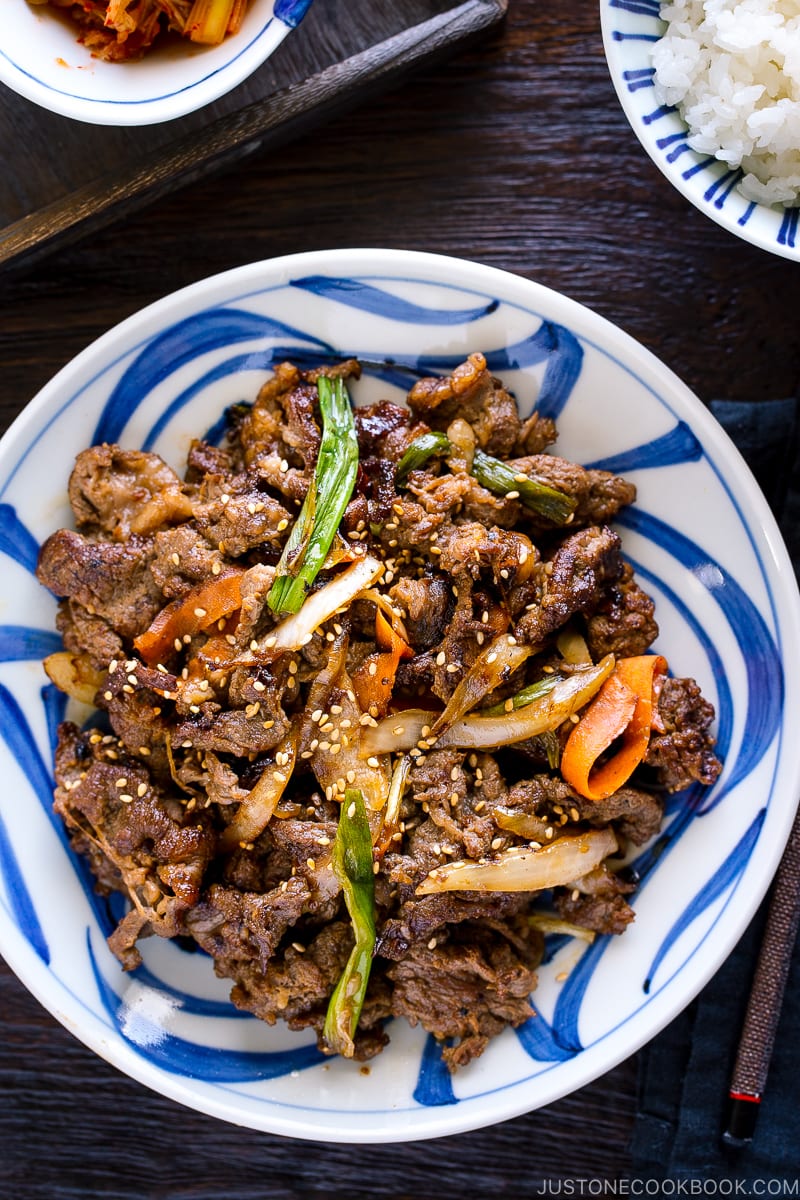
Grilling season is here and I want to share one of my family's favorite grilled meat recipes, Bulgogi — the Korean BBQ beef. Intensely flavorful and delicious, it is undoubtedly some of the tastiest dishes to put on the grill.
When the marinated meat hit the sizzling skillet, you can immediately smell the tantalizingly sweet & smoky aroma fills the hot summer air. Love your grilled meat with big bold flavors? You will have to give this Beef Bulgogi recipe a try!
Table of Contents
- What is Bulgogi?
- 5 Tips to Make Delicious Bulgogi
- 1. Add grated Korean / Asian pear
- 2. Use Korean soy sauce
- 3. Marinate overnight
- 4. Do not add the marinade liquid into the hot skillet
- 5. Cook on hot skillet
- Bulgogi for An Easy Weeknight Family Meal
What is Bulgogi?
Bulgogi (불고기) is a classic Korean preparation of beef or pork in which thinly shaved meat is marinated in a sweet and savory sauce, and grilled on a barbecue or on a stove-top griddle. Literally "fire" and "meat," bulgogi has been in existence for nearly over a thousand years. It was even considered a fashionably high-class cuisine during the Joseon Dynasty.
With Korean barbecue restaurants becoming the mainstay of Japan's food scene in recent years, a lot of housewives started making bulgogi (プルコギ) at home.
I love that it makes a wholesome one-skillet dinner for the family, especially when you cook it with vegetables like I did in this recipe.
Ingredients You'll Need
- Vegetables:I used onion, green onions/ scallion, and thinly shaved carrot, but you can also use other veggies such as bell peppers, bok choy, spinach, or bean sprouts.
- Cut of Beef:Thinly sliced beef (chuck or rib eye) are best, but you can use tenderloin or top sirloin; If you can't find thinly sliced beef, you can freeze the block of meat for 2 hours prior to slicing (See my tutorial).
- Bulgogi Marinade: Korean soy sauce*, roasted sesame oil, brown sugar, garlic, Korean pear*, and freshly ground black pepper.
- Sesame Oil
- Toasted sesame seeds
* See details in the Tips section
5 Tips to Make Delicious Bulgogi
1. Add grated Korean / Asian pear
The SECRET ingredient for bulgogi's tantalizing sweetness and melt-in-mouth texture is the Korean pear added in the marinade. Unlike other varieties, Korean pear (also called the Asian pear or apple pear) contains more moisture and juice, and has an enzyme that tenderizes the meat.
They appear in the grocery stores in the fall and winter months. It's a lot easier to find them in Asian (Chinese, Korean, Japanese) grocery stores but even my local Costco carries them during the season. In Japan, we call these pears "Nashi" (梨).
Korean pear may not be available in all seasons, but it's totally worth hunting down when you make bulgogi at home. I didn't expect I could get hold of a Korean pear in May at my local American grocery store. You never know until you look for it!
2. Use Korean soy sauce
Not all soy sauce is created equally! Korean soy sauce has a different richness, consistency, and flavor when compared to a Japanese soy sauce or a Chinese soy sauce. As it is one of the key flavors in bulgogi, you'll notice a difference if you use other type of soy sauce.
Ideally, if you wish to cook up a flavorsome bulgogi and other Korean dishes, use only Korean soy sauce as it works best for the characteristic of the cuisine. On the other hand, I use only Japanese soy sauce for all my Japanese cooking.
3. Marinate overnight
In my recipe below, I stated a minimum of 30 minutes for marinating, but I still highly recommend overnight so the beef will be more tender and have enough time to soak up all the flavors.
4. Do not add the marinade liquid into the hot skillet
The trick in giving a nice char to the beef is to use a pair of tongs to pick up the meat from the marinade, leaving the marinade liquid behind. You need to place just the meat on the hot skillet, no liquid goes into the skillet. Otherwise, you would end up steaming the meat with liquid in the pan. Make sure you coat each piece of the sliced beef well with your hands covered with plastic and let them absorb the flavors while marinating.
5. Cook on hot skillet
Whether you use an outdoor barbecue grill or cook over the stovetop, you want to make sure the skillet/ pan is hot. That's when the sliced meat gets nicely charred and caramelized quickly.
If using an outdoor barbecue grill, make sure to cook the meat on a skillet so the small pieces of meat won't fall between the grill grates. I like to use a cast-iron skillet.
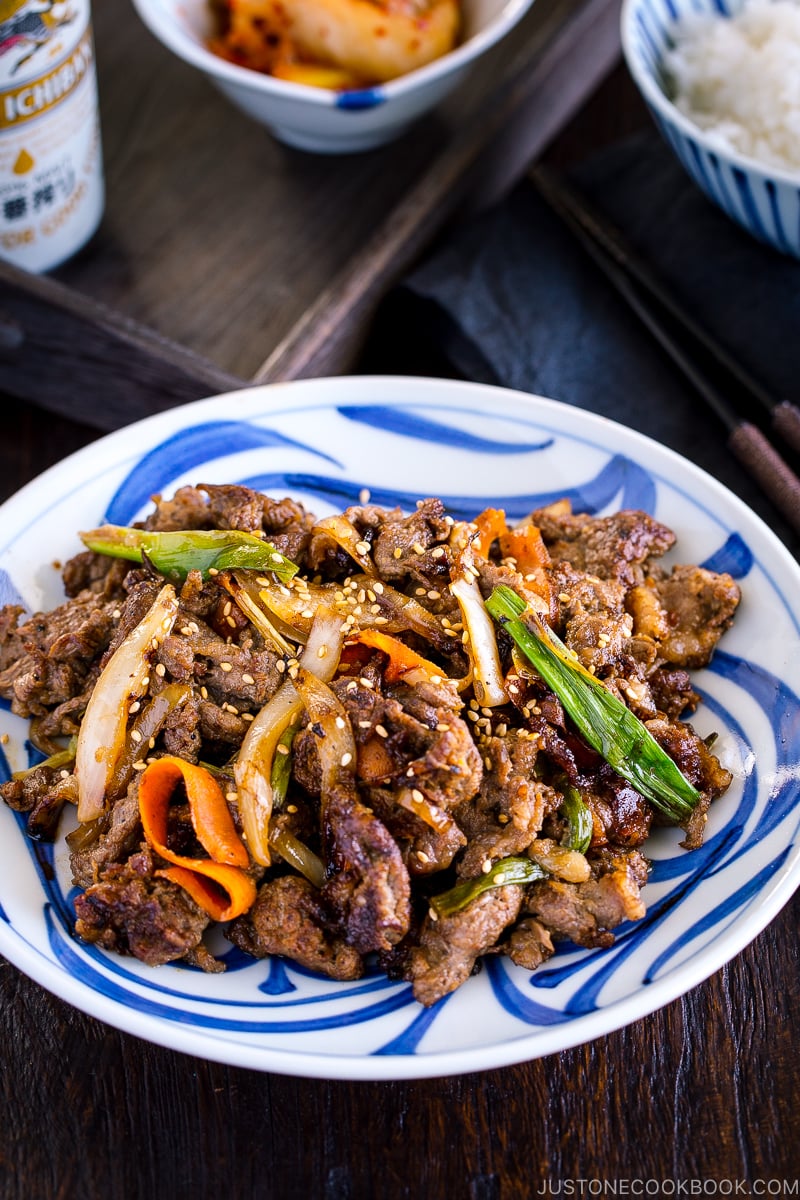
Bulgogi for An Easy Weeknight Family Meal
In the summertime, I often serve Bulgogi with steamed rice and kimchi on the side for a quick and easy weeknight family meal. If you are hosting a BBQ, this Korean grilled meat also makes a fabulous finger food when served on lettuce wraps. Enjoy with some icy cold beer or lemonade.
Oh, don't forget to save a portion of leftover bulgogi meats for Bulgogi Onigirazu the next day! The rice sandwich is a delicious meal on its own.
Side Dishes to Serve with Bulgogi
For a more elaborate meal, here are some amazing side dishes that pair well with this Korean Beef Bulgogi:
- Quick Korean Fresh Kimchi
- Korean Spinach Namul and Bean Sprout Namul
- Onigiri Rice Balls
- Spicy Pickled Cucumbers
- Spicy Bean Sprout Salad
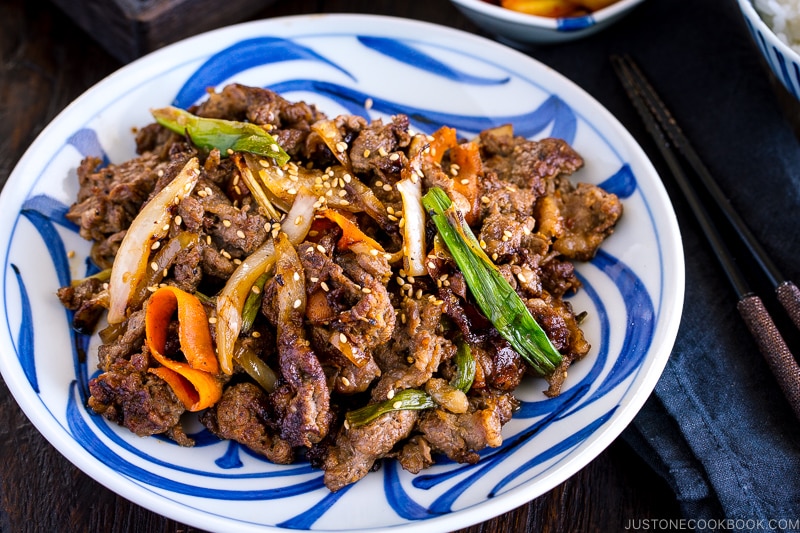
Wish to learn more about Japanese cooking?Sign up for our freenewsletter to receive cooking tips & recipe updates! And stay in touch with me on Facebook, Pinterest, YouTube, and Instagram.
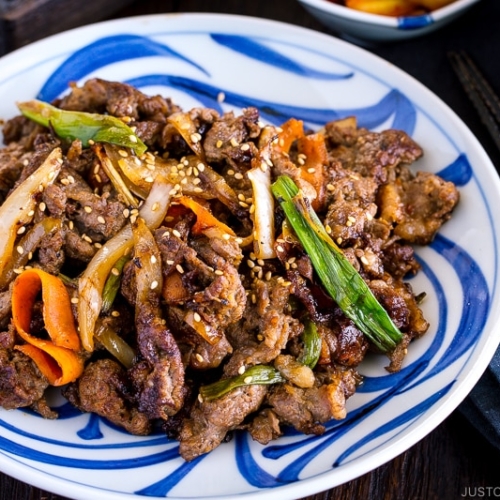
Bulgogi (Korean Grilled Beef)
Bulgogi, a classic Korean grilled beef, is so easy to make and fun to eat with friends and family. Tender pieces of caramelized beef with crunchy sweet vegetables, this flavorful BBQ meat needs to make an appearance on your summertime dinner soon! You can grill on a barbecue or on a stove-top griddle.
Servings: 4
Prevent your screen from going dark
- ½ onion
- 3 green onions/scallions
- 4 inch carrot
- 1 ½ lb thinly sliced beef (chuck or rib eye) (can also use tenderloin, top sirloin; If you can't find thinly sliced beef, you can freeze the block of meat for 2 hours (depending on the size and thickness) prior to slicing (See my tutorial).
- 1 Tbsp roasted sesame oil
- ½ Tbsp toasted white sesame seeds (for topping)
Bulgogi Marinade
- 4 Tbsp Korean soy sauce
- 2 Tbsp roasted sesame oil
- 3 Tbsp brown sugar (don't substitute with honey as it burns easily)
- 8 cloves garlic (4 tsp, minced)
- ½ Asian pear (4 Tbsp, grated; Substitute Asian pear with apple, like Fuji apple, kiwi, or fresh pineapple (a canned variety deactivates an enzyme).
- freshly ground black pepper
Japanese Ingredient Substitution: If you want substitutes for Japanese condiments and ingredients, click here.
-
Gather all the ingredients.
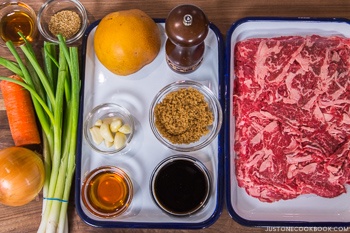
-
To make the bulgogi marinade, add 4 Tbsp soy sauce, 2 Tbsp sesame oil, and 3 Tbsp brown sugar, and crush 8 cloves garlic (or minced garlic) in a large bowl.
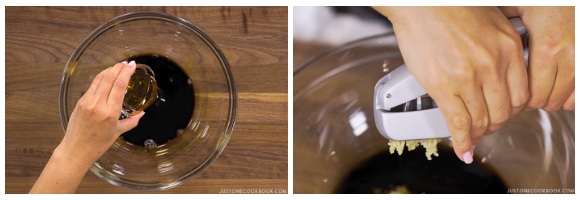
-
Grate ½ of an Asian pear.
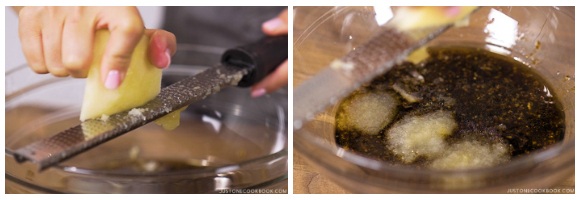
-
Add freshly ground black pepper and mix all together.
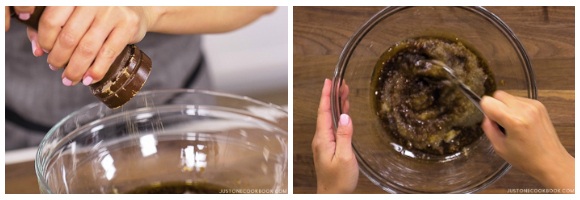
-
Cut the onion into thin slices and cut the green onion into 2 inches (5 cm) pieces and then cut in half lengthwise.
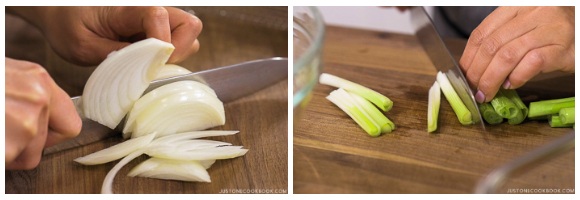
-
Using a peeler, peel some carrot (or slice thinly). Add the onion, green onions, carrot in the marinade, and mix all together.
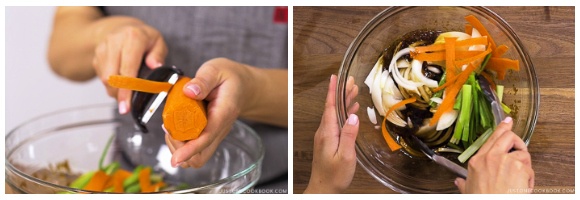
-
Add the meat in the marinade, separating each slice. Mix all together to coat with the marinade. I wear plastic gloves so I can mix them thoroughly.
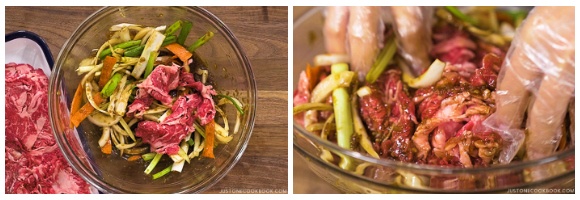
-
Set aside for at least 30 minutes or best if overnight.
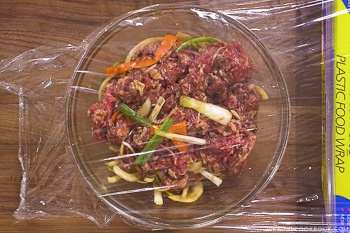
-
In a large skillet (I use a cast iron grill pan here), heat 1 Tbsp sesame oil over medium-high.
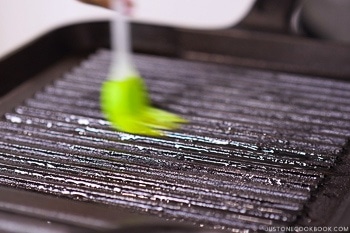
-
Cook the marinated meat in a single layer until cooked through, about 5 minutes. Transfer the meat to the plate and sprinkle with sesame seeds.
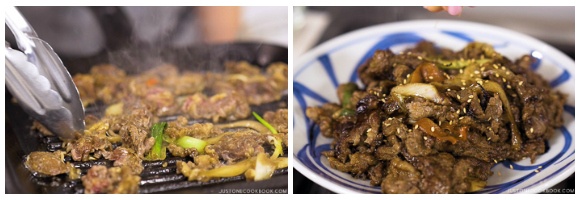
-
If you have a single serving cast iron plate, you can use it to keep the meat warm for a longer time.
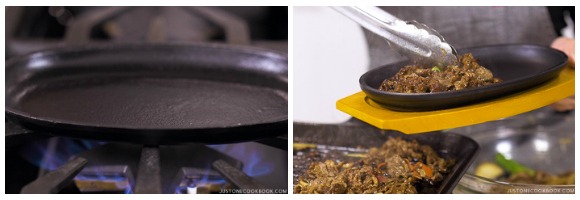
Calories: 480 kcal · Carbohydrates: 14 g · Protein: 36 g · Fat: 32 g · Saturated Fat: 12 g · Cholesterol: 104 mg · Sodium: 582 mg · Potassium: 603 mg · Fiber: 2 g · Sugar: 8 g · Vitamin A: 2215 IU · Vitamin C: 7 mg · Calcium: 52 mg · Iron: 3 mg
Course: Main Course
Cuisine: Korean
Keyword: korean beef, marinated meat, thinly sliced meat
©JustOneCookbook.com Content and photographs are copyright protected. Sharing of this recipe is both encouraged and appreciated. Copying and/or pasting full recipes to any website or social media is strictly prohibited. Please view my photo use policy here.
If you made this recipe, snap a pic and hashtag it #justonecookbook! We love to see your creations on Instagram @justonecookbook!
Editor's Note: This post was originally published on June 26, 2017. The post has been updated in June 2020.
Subscribe Now!
5 Secrets to Japanese Cooking: Simple Meals & Authentic Flavors!
Sign up to receive our FREE email series on Japanese cooking tips and weekly newsletter.
Source: https://www.justonecookbook.com/bulgogi-korean-grilled-beef/
0 Response to "What Type of Beef Is Bulgogi"
Post a Comment